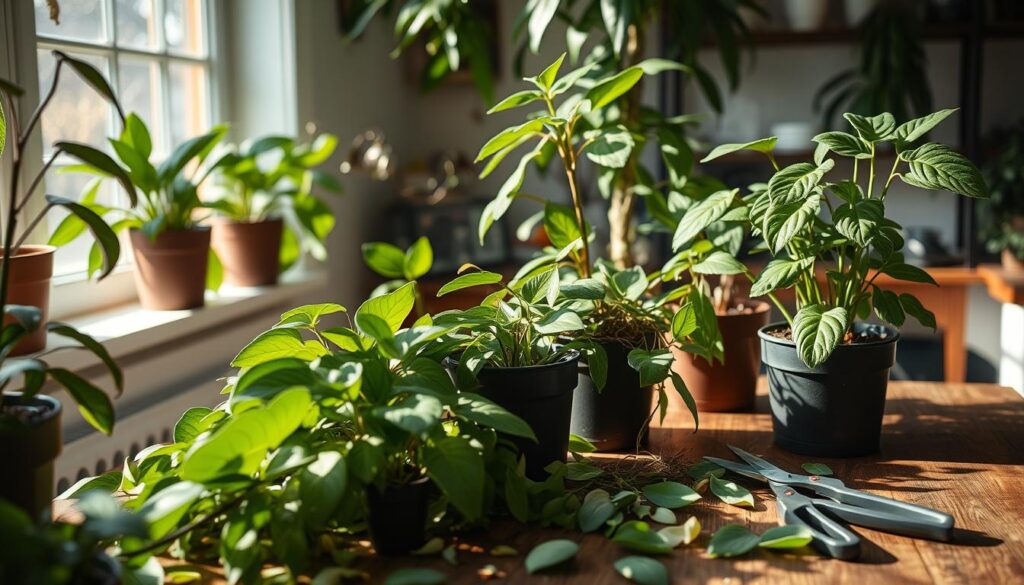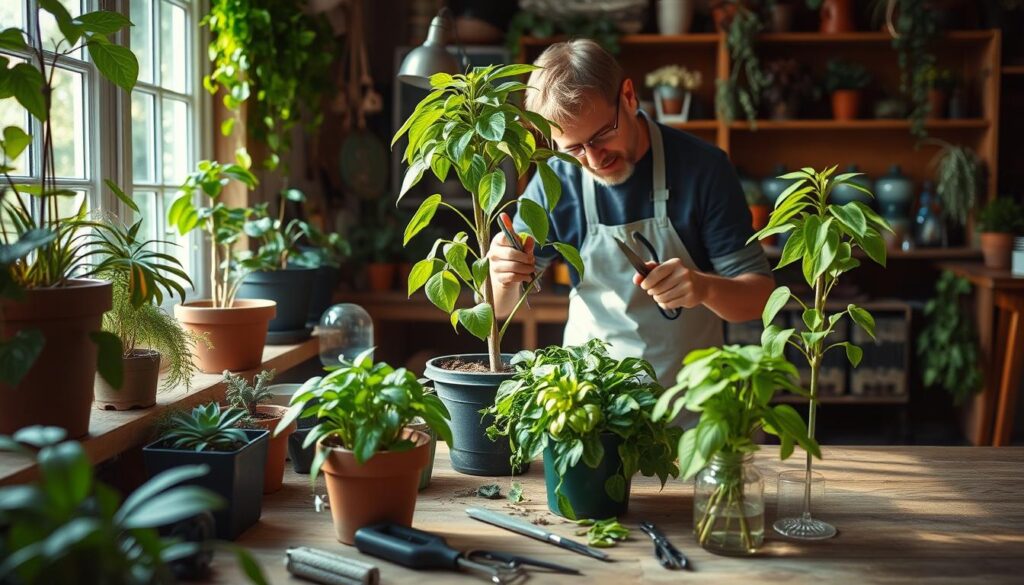Did you know that about 90% of plant owners forget the importance of indoor plant pruning? This can lead to stunted growth and health problems in their plants. Learning how to prune is key for anyone who loves plants and wants a lively indoor garden.
In this article, we’ll share important tips and best practices for indoor plant pruning. These will help you keep your plants healthy and thriving. You’ll learn how to improve your indoor plants’ look and health.
Key Takeaways
- Understanding indoor plant pruning is crucial for maintaining plant health.
- Pruning helps promote robust growth and can enhance the overall aesthetic of your indoor garden.
- Timing your pruning efforts is vital for different plant types and seasons.
- Using the right tools is essential for effective indoor plant pruning.
- Avoid common mistakes to ensure your plants thrive post-pruning.
- Propagating new plants through pruning can expand your indoor garden.
- Creating a pruning schedule ensures consistent care for your green companions.
Understanding the Basics of Indoor Plant Pruning
Pruning indoor plants is key to keeping them healthy and lively. Learning how to prune helps plant owners keep their gardens looking great. This part covers what pruning is, why it’s good, and the tools you need.
What is Pruning?
Pruning means cutting off parts of a plant on purpose. It makes the plant healthier and helps control its size and shape. Regular pruning makes your plants look better and encourages them to grow.
Benefits of Pruning Your Indoor Plants
Pruning has many benefits:
- Promotes new growth and flowering
- Removes dead, damaged, or diseased branches
- Improves air circulation and light penetration
- Enhances the overall aesthetics of the plant
- Prevents overcrowding within the plant
Common Tools for Pruning
Having the right tools for pruning is important. Here are some common ones:
| Tool | Purpose |
|---|---|
| Pruning Shears | Ideal for cutting small branches and stems. |
| Scissors | Useful for snipping away smaller leaves or delicate stems. |
| Loppers | Great for tackling larger branches that are difficult to reach. |
When to Prune Indoor Plants
Timing is key when pruning indoor plants. Knowing when to prune can boost your plant’s health and growth. Paying attention to seasonal changes and pruning signs is crucial for your plants’ well-being.
Seasonal Considerations
The best time to prune many indoor plants is in late winter or early spring. This helps them prepare for new growth. On the other hand, pruning during the dormant season can stress them out and slow their growth. Understanding when to prune is vital for your plants’ health.
Signs Your Plant Needs Pruning
Being aware of pruning signs is important for keeping indoor plants healthy. Look out for:
- Leggy growth where the stems become stretched and sparse.
- Yellowing leaves, which can signal poor health or overwatering.
- An overall unkempt and messy appearance of the plant.
Spotting these signs helps you prune at the right time. This lets your plants get back to their best.
Techniques for Effective Pruning
Learning how to prune indoor plants well can make them healthier and look better. It’s important to know how to use your tools right and pick the best method. Here are some key ways to get the best results.
How to Use Pruning Shears
Using pruning shears correctly is key when trimming indoor plants. Make sure they are sharp to avoid hurting the plant. This can cause diseases. Clean the blades before you start to prevent spreading diseases.
Hold the shears at an angle for precise cuts. Target stems, not leaves, when you can.
Topping vs. Thinning
There are two main pruning methods: topping and thinning. Topping cuts the top of the plant to make it bushier. It encourages more growth on the sides. Thinning, on the other hand, reduces branches or leaves to improve air and light.
Both methods can make your plants look better and be healthier.
Making Clean Cuts
Making clean cuts is a crucial part of pruning. Try to make sharp cuts to avoid harming the plant. This helps it heal faster and reduces infection risk.
Always cut just above a node or leaf junction. This helps new growth come in the right places. Clean cuts help the plant focus on growing and healing.
Pruning Specific Types of Indoor Plants
Different indoor plants need special care when pruning. Knowing what each type needs helps them grow well and look great.
Pruning Foliage Plants
Pruning foliage plants keeps them looking neat and healthy. It removes dead or yellow leaves. This lets the plant grow new leaves.
- Trim back too much growth to shape the plant.
- Take out damaged leaves to stop disease.
- Always cut just above a leaf node to help new growth.
Pruning Flowering Plants
Pruning flowering plants makes them bloom more. Prune after they’ve finished blooming. This helps them grow new flowers.
- Remove old flowers to look better and save energy.
- Shorten long stems for a balanced look.
- Thin out branches to keep air moving.
Caring for Succulents
Succulents need careful pruning because they store water. Pruning too much can cause them to dry out. Just trim off dead or too much growth to keep their shape.
- Use sharp tools to avoid hurting the plant.
- Make small changes to keep their look.
- Let cut ends dry before replanting to avoid rot.

| Plant Type | Pruning Frequency | Key Considerations |
|---|---|---|
| Foliage Plants | Every 4-6 weeks | Focus on shape and removing dead leaves |
| Flowering Plants | Post-blooming | Encourage blooms by cutting spent flowers |
| Succulents | As needed | Gentle pruning to maintain health |
Seasonal Pruning Guide
Keeping your indoor plants healthy all year is rewarding but can be tough. A good indoor plant pruning guide offers tips for each season. Knowing what to do in each season makes caring for your plants easier and more rewarding.
Spring Pruning Essentials
In spring, it’s time to refresh your plants. Start by cutting off dead or damaged branches. This helps new growth thrive. Also, trim back too much foliage to improve air and light, helping your plants grow well.
Summer Maintenance Tips
Summer is the time to watch your plants closely. Check for pests and diseases often. Prune long stems to control growth and keep your plants looking good.
Fall and Winter Care
Fall brings a change in how you care for your plants. Consider cutting them back a bit to get ready for winter. In winter, be careful not to prune too much. Let your plants rest and recharge.
Common Pruning Mistakes to Avoid
Pruning indoor plants is an art that needs care and knowledge. Knowing common mistakes can greatly help keep your plants healthy. Simple errors can stress your plants, harming their growth and health. It’s key to know these mistakes to have a thriving indoor garden.
Over-Pruning Your Plants
Over-pruning is a big mistake. Cutting too much foliage hampers photosynthesis, causing poor growth and stress. It’s important to prune carefully to keep the plant’s natural shape and health. Try to cut no more than a third of the foliage at once.
Choose which branches to trim wisely. This helps keep your plants looking lush and growing strong.
Ignoring Plant Health
Pruning without checking the plant’s health can harm it. Always check your plant’s condition before pruning. Cutting a sick plant can make things worse and spread disease.
Make sure to clean your pruning tools to avoid spreading infections. Look for signs of trouble like yellow leaves or wilting. Keeping your plants healthy should be your main goal when pruning.
| Common Mistake | Description | Effect on Plant |
|---|---|---|
| Over-Pruning | Removing excessive foliage | Stress and poor growth |
| Ignoring Health Signs | Failing to assess plant condition | Potential spread of diseases |
| Improper Tool Sanitization | Not cleaning tools before use | Introducing infections |
| Pruning at the Wrong Time | Timing cuts poorly within seasons | Weak growth and delayed recovery |
Encouraging New Growth After Pruning
After pruning your indoor plants, it’s time to focus on growth. Proper care is key for their health. This includes fertilizing and watching how they recover.
Fertilizing After Pruning
Give your plants a balanced fertilizer after pruning. It should have nitrogen, phosphorus, and potassium. This helps them grow strong and green again. Fertilize about two weeks later to boost their recovery.
Monitoring Your Plant’s Recovery
Watch your plants closely after pruning. Look for new growth and any problems. Make sure they get enough light and water.
Too much water can cause root rot. Not enough water slows growth. This careful post-pruning care ensures your plants do well after pruning.
Propagating Plants through Pruning
Pruning your indoor plants is a great way to grow new ones. You can take cuttings from healthy plants to create new specimens. This method lets you share your love for plants without buying new ones.
Techniques for Propagation
There are many ways to propagate plants through pruning. Experts often suggest these methods:
- Stem Cuttings: Cut healthy stems and put them in water or soil to root.
- Leaf Cuttings: Some plants can grow from single leaves, making it a quick method for certain species.
- Division: For plants with many stems, dividing the roots can create new plants.
Best Practices for Rooting Cuttings
Here are some tips for successful rooting cuttings:
- Choose cuttings from healthy plants for the best chance of success.
- Use clean, sterilized tools to make cuts and avoid infections.
- Keep the cuttings moist and warm for the best rooting conditions.
- Check on the cuttings often to make sure they stay hydrated.

Learning these plant propagation techniques can make your indoor garden grow. It adds beauty and sustainability to your home. Pruning is a way to bring new life into your indoor space.
Creating a Pruning Schedule
Setting up a pruning schedule for indoor plants can really help your gardening routine. Knowing when to prune keeps your plants healthy and looking good. The right time to prune varies by plant, but checking every few months is a good rule of thumb.
How Often to Prune
Each plant has its own pruning needs. Here’s a basic guide for common indoor plants:
| Plant Type | Pruning Frequency | Notes |
|---|---|---|
| Foliage Plants | Every 6-8 weeks | Focus on dead or yellow leaves. |
| Flowering Plants | Every 4-6 weeks | Encourages blooming and removes wilted flowers. |
| Succulents | Every 2-3 months | Be cautious; only remove damaged leaves. |
Keeping Track of Your Plants
It’s important to keep an eye on your plants’ health. You can use a gardening journal or digital apps to track them. Make sure to note:
- Pruning dates and techniques used.
- Signs of growth or stress.
- General observations about plant health.
Having a regular pruning schedule helps you keep track of your plants. It also makes gardening indoors more enjoyable. With proper care, your plants will thrive and make your space beautiful.
Conclusion: Embracing the Art of Pruning
Pruning indoor plants is key to keeping them healthy and strong. Learning the right techniques, timing, and tools is crucial. Every cut you make can make your plants grow better and look more vibrant.
Recap of Key Tips
Pruning is more than just cutting off extra leaves. It helps your plants grow stronger and encourages new growth. Paying attention to the right time and knowing when your plants need help is important. Avoid cutting too much and always check your plants’ health.
By following these tips, you can create a beautiful indoor garden. It will flourish under your care.
Continuing Your Plant Care Journey
Now that you know more about pruning, you can keep your plants in top shape. Regular pruning keeps them looking good and healthy. Keep learning and adjusting your methods as you see how your plants respond.
By sticking with it, you’ll create a space where your plants can grow and thrive.
FAQ
What tools are essential for indoor plant pruning?
You’ll need pruning shears, scissors, and sometimes loppers for big branches. Sharp, clean tools are key for good pruning and to protect your plants.
How do I know when to prune my indoor plants?
Prune in late winter or early spring. Look for yellow leaves, leggy growth, or when plants get too crowded.
What are some best practices for indoor plant pruning?
Make clean cuts and don’t over-prune. Know your plant’s health. Sterilize tools to stop disease spread.
Can I propagate my indoor plants through pruning?
Yes, you can. Take healthy cuttings and root them in water or soil to grow new plants.
What should I do after pruning my indoor plants?
Fertilize after pruning to help them recover. Watch their growth and make sure they get enough light and water.
How often should I check my indoor plants for pruning needs?
Check every few months. The need can change by plant type. Keeping a pruning schedule helps plant health.
What common mistakes should I avoid when pruning indoor plants?
Avoid over-pruning and not cleaning your tools. Prune carefully to keep your plants healthy.
How can I encourage new growth after pruning?
Fertilize and ensure the right conditions. Light, moisture, and watching for issues help new growth.
What specific techniques are best for pruning different types of indoor plants?
Techniques vary by plant. Trim foliage plants, prune flowering ones for blooms, and gently prune succulents to keep water in.


